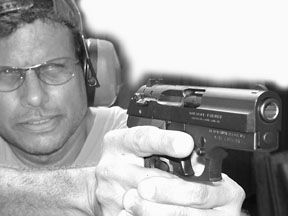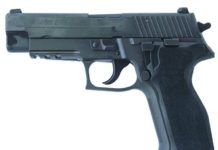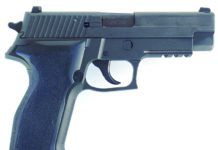
Looking through the pages of the many different gun magazines, any shooter might be dizzied by the advertisements alone. New models seem to appear with every issue, while simple updates in the finish or style of an old design are trumpeted as well. In this test we will try out two pistols that get less than their share of press, the $620 SIGArms P239 and the $702 Beretta Mini Cougar 8040, both chambered for the stout .40 S&W round.
The P239, first issued in 9mm, has since been successfully chambered in much more powerful calibers such as the .357 SIG (see Gun Tests, August 2001) and the .40 S&W. The P239 is unusual among the SIGArms lineup. The P239 is one of few pistols in the Sigarms lineup that feed from a single-column magazine. Like the Beretta pistol in this test, most of the SIGArms pistols use a higher-capacity double-column magazine that results in a much wider and rounder profile at the grip. In terms of compact design we think of the P239 as a TDA variation of Colt’s Officer’s .45 ACP model. Both pistols share the advantages of being flat and easy to conceal while offering a natural point to the shooter’s hand.
Compared to the SIGArms P239, the Beretta 8040 Mini Cougar is a more sophisticated weapon. The decocker lever (found on both sides of the pistol) can also disconnect the trigger, rendering the gun completely safe. Hammer-back safety on, or cocked-and-locked carry is not an option, however.
We learned a lot more about these two pistols when we loaded magazines and went to the range. Here’s what we found out.
[PDFCAP(1)]The P239 offers several physical advantages over many pistols. The narrow gun was virtually snag-free, and it was as slippery smooth as those expensive “melt-down” jobs offered by custom gunsmiths. A melt down reduces the profile of necessary levers and rounds off the outer edges of the frame and slide. This makes it an ideal carry gun, especially when stowed in a false compartment of a briefcase or purse. The P239 fit especially well in a Galco concealment model without spoiling the purse’s stylish profile. Also, pulling the P239 from a holster or purse works well because this pistol can be operated with one hand. It comes equipped for the right-handed shooter, however. Of the three controls on the left side of the pistol (slide release, decocking lever and magazine release), only the mag button can be relocated to the right side.
The only remaining lever on the pistol was the breakdown lever, which makes field-stripping easy. Lock back the slide, turn the lever down and the top end slides off. This is a linkless design, so there was no slide stop to remove or misplace. The top end consisted of the slide, 3.5-inch barrel, a hollow metallic guide rod, and flat wound spring. With the top end removed, the frame is remarkably light despite the presence of the trigger and decocking mechanism housed therein. However, neither the Beretta nor the P239 are terribly light, weighing in at approximately 33 to 34 ounces each. Frankly, with chambering for the powerful .40 S&W round, we welcomed some ballast against recoil.
Capacity of the P239 is seven rounds in the magazine plus one in the chamber. We tested the standard model that sells for an MSRP of $620. Available options include a blued night sight model for $720, and a two-tone gun with night sights priced at $765. But we liked the standard finish, flat black on the frame topped with a blackened stainless-steel slide. (We should note that the frame is made in Germany, and the slide is forged in the United States.)
We also liked the standard sights and wish they could be faithfully rendered in tritium. Proper alignment had a white rectangle with a large white dot sitting on top of it. The rectangle was centered in the rear notch and the front sight showed the dot.
We performed two different tests with each gun. After we had spent a day firing different types of ammunition, we returned to the range for accuracy tests, fired single action only, at 15 yards from a sandbag rest and also multiple strings of fire at 7 yards. In this test, we presented the gun from low ready and fired two shots in rapid succession at a Milpark target, commonly used in USPSA/IPSC competition. We developed this procedure to grade how easily the operator could transfer from double to single action and land shots with speed at a consistent point of impact. We tried a number of different types of ammunition featuring different bullet weights, but found that both guns favored lighter, faster rounds.
[PDFCAP(2)]Not only that, we found that the accuracy of each pistol fired single action from the bench was comparable. In fact, each gun was able to print average group sizes of five shots that measured about 1.3 inches at 15 yards in combination with the Winchester USA 165-grain FMJ rounds. The SIG landed the smallest single group of the test with this round, measuring only 1.0 inches from center to center. One of our favorites, this same 165-grain Winchester USA round has consistently proved accurate and comfortable to shoot in our previous tests of .40 S&W handguns. We also tried a series of different 180-grain rounds during our shakedown session, but found that it made our two test guns feel out of balance. The heavier, slower-moving 180-grain bullets made the guns feel sluggish. There was also a noticeable increase in muzzle flip, which seemed to affect the balance of the gun.
Our next test round was a 155-grain jacketed hollowpoint from Black Hills. For some reason we’ve never seen really good results with this bullet weight in .40 S&W, and test results were in the 2.5-inch range. The hottest round we tested actually showed signs of pressure, slightly bulging the impact point on the primer. Nevertheless, Cor-Bon’s 135-grain JHPs were sent downrange at more than 1250 fps and printed some very impressive groups.
The SIG produced groups ranging from 1.5 to 1.9 inch inches. But we were reminded that these guns were designed to be carried with a loaded chamber, hammer down, first shot double action. You may have heard about cocking the hammer in a “condition red” situation, but we prefer to practice a rapid transition from DA to SA that gives us speed and accuracy with maximum safety of operation. The drill to develop this technique is simple to perform. The key ingredient is a consistent trigger press. For success you must ignore the change of position the trigger suffers during transition from DA to SA. You must also ignore the change in weight of the two triggers while moving the finger forward and back at the same speed. If you do nothing else correctly, move your trigger finger the same distance back and forth each time you press the trigger.
For this test we started with the soft-shooting Winchester ammunition. The results firing the P239 were outstanding. The narrow gun helped us maintain a consistent grip and easily locate the trigger. We performed a total of 30 shots consisting of 15 separate strings of fire. We felt at ease throughout the drill and printed a group that measured approximately 6 inches in diameter. Firing the more powerful ammunition, we had to work harder to shoot a tight group, but the friendly frame size helped us apply a more concentrated grip.
[PDFCAP(3)]Capacity of the Mini Cougar was determined by which of the two supplied magazines were used. The eight-round double-column magazine fit flush to the grip, making the gun more concealable. The 10-round magazine was approximately 1 inch longer and made the gun appear more symmetrical. The lower inch of this magazine was shrouded in a molded extension that adds flawlessly to the grip. In the past we have heard concerns regarding the use of full-length magazines in compact versions of the full-size pistols. Though other pistols risk malfunction with this practice, the Mini Cougar was designed from the ground up to use a shrouded magazine to extend the grip. We suffered no malfunctions with either the eight- or ten-round magazines in place. The only difference was if we could place all four fingers on the grip, depending on the size of the hand. Also, we noticed that when the shooter pressed the magazine release, the magazine sometimes hung up in the palm of the hand. This is something to watch.
Unlike the 92 and 96 series Berettas, the Mini Cougar employs a rotating barrel. Between the barrel and the frame is a supporting block that mates a barrel lug with a channel beneath the barrel chamber. As the slide moves back, the barrel is forced to move as well. The lug follows the channel and rotates the barrel, exposing the empty case to the ejection port.
This design helps improve lockup in a number of ways. The first and most obvious advantage is the inherent strength of the locking components themselves. Barrel movement is limited, therefore reducing wear and improving consistency. Another advantage is one we were able to feel right away. The Beretta Mini Cougar demonstrated noticeably less felt recoil than the SIGArms P239 did.
To most shooters this design is unique, so we recommend reading the manual before removing the top end. Beyond pressing the right-side button and rotating the slide release, taking down the Mini Cougar is much different than a model 92. Properly replacing the block and applying the recoil spring/guide rod unit is key.
To our way of thinking the Mini Cougar offered strength and durability, safety and more versatility in terms of concealment than most semi-autos that load from the double-column magazine design. But how well did it shoot?
When fired single action only from a sandbag rest, the Mini Cougar tied the SIGArms P239 firing the Winchester rounds, but it shot tighter groups when loaded with the Black Hills and Cor-Bon ammunition. However, the margin was small enough when fired supported that we think the accuracy of our two test guns was comparable. But during the practical test, we found a stark difference in performance.
Firing the lightly recoiling Winchester USA rounds, the 8040’s results were clearly not as good as the P239’s performance. Firing the hottest loads, in this case the 135-grain Cor-Bon rounds, the gap in performance between the two guns shrank. We found that the hotter the loads, the better the Mini Cougar felt. But the one aspect that we think hurt the Beretta in this phase of testing was the heavy trigger in both single and double action. The single-action pull measured 8 pounds.
This is quite heavy, but the double-action press came in at a whopping 18 pounds. To our recollection, this is the heaviest DA trigger we’ve measured. The good news was both the DA and SA triggers were smooth and void of excessive take-up or dead spots. We would pay a gunsmith to lower the trigger-pull weights to 12 pounds DA and 6 pounds SA.
Gun Tests Recommends
SIGArms P239 .40 S&W, $620. Buy It. Slim, concealable, and accurate, this is what compact firepower is all about. The P239’s trigger is possibly the best example of a TDA system we’ve found. Even dyed-in-the-wool 1911 shooters should find it easy to adapt.
Beretta Mini Cougar 8040 40S&W, $709. Conditional Buy. If you are not a fan of cocked-and-locked carry but prefer a true mechanical safety, this is an excellent alternative. We liked the higher capacity and versatility of this weapon plus the way it handled the hottest defense loads. However, the DA trigger was far too heavy in our view, and it would require work before we could unconditionally recommend it.
Also With This Article
[PDFCAP(4)]




























